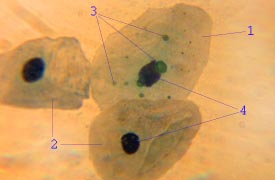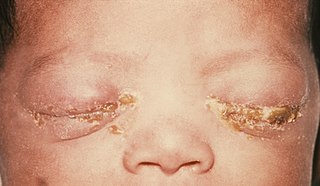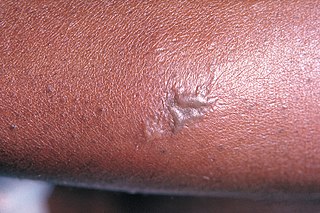Related Research Articles

Chlamydia, or more specifically a chlamydia infection, is a sexually transmitted infection caused by the bacterium Chlamydia trachomatis. Most people who are infected have no symptoms. When symptoms do appear they may occur only several weeks after infection; the incubation period between exposure and being able to infect others is thought to be on the order of two to six weeks. Symptoms in women may include vaginal discharge or burning with urination. Symptoms in men may include discharge from the penis, burning with urination, or pain and swelling of one or both testicles. The infection can spread to the upper genital tract in women, causing pelvic inflammatory disease, which may result in future infertility or ectopic pregnancy.

Pelvic inflammatory disease, also known as pelvic inflammatory disorder (PID), is an infection of the upper part of the female reproductive system, namely the uterus, fallopian tubes, and ovaries, and inside of the pelvis. Often, there may be no symptoms. Signs and symptoms, when present, may include lower abdominal pain, vaginal discharge, fever, burning with urination, pain with sex, bleeding after sex, or irregular menstruation. Untreated PID can result in long-term complications including infertility, ectopic pregnancy, chronic pelvic pain, and cancer.
Urethritis is the inflammation of the urethra. The most common symptoms include painful or difficult urination and urethral discharge. It is a commonly treatable condition usually caused by infection with bacteria. This bacterial infection is often sexually transmitted, but not in every instance; it can be idiopathic, for example. Some incidence of urethritis can appear asymptomatic as well.

Conjunctivitis, also known as pink eye, is inflammation of the outermost layer of the white part of the eye and the inner surface of the eyelid. It makes the eye appear pink or reddish. Pain, burning, scratchiness, or itchiness may occur. The affected eye may have increased tears or be "stuck shut" in the morning. Swelling of the white part of the eye may also occur. Itching is more common in cases due to allergies. Conjunctivitis can affect one or both eyes.

Trichomoniasis (trich) is an infectious disease caused by the parasite Trichomonas vaginalis. About 70% of affected people do not have symptoms when infected. When symptoms occur, they typically begin 5 to 28 days after exposure. Symptoms can include itching in the genital area, a bad smelling thin vaginal discharge, burning with urination, and pain with sex. Having trichomoniasis increases the risk of getting HIV/AIDS. It may also cause complications during pregnancy.

Chlamydia trachomatis, commonly known as chlamydia, is a bacterium that causes chlamydia, which can manifest in various ways, including: trachoma, lymphogranuloma venereum, nongonococcal urethritis, cervicitis, salpingitis, pelvic inflammatory disease. C. trachomatis is the most common infectious cause of blindness and the most common sexually transmitted bacterium.
Mycoplasma hominis is a species of bacteria in the genus Mycoplasma. M. hominis has the ability to penetrate the interior of human cells. Along with ureaplasmas, mycoplasmas are the smallest free-living organisms known.

Mycoplasmataceae is a family of bacteria in the order Mycoplasmatales. This family consists of the genera Mycoplasma and Ureaplasma.

Chlamydia pneumoniae is a species of Chlamydia, an obligate intracellular bacterium that infects humans and is a major cause of pneumonia. It was known as the Taiwan acute respiratory agent (TWAR) from the names of the two original isolates – Taiwan (TW-183) and an acute respiratory isolate designated AR-39. Briefly, it was known as Chlamydophila pneumoniae, and that name is used as an alternate in some sources. In some cases, to avoid confusion, both names are given.

Endometritis is inflammation of the inner lining of the uterus (endometrium). Symptoms may include fever, lower abdominal pain, and abnormal vaginal bleeding or discharge. It is the most common cause of infection after childbirth. It is also part of spectrum of diseases that make up pelvic inflammatory disease.

Neonatal conjunctivitis is a form of conjunctivitis which affects newborn babies following birth. It is typically due to neonatal bacterial infection, although it can also be non-infectious. Infectious neonatal conjunctivitis is typically contracted during vaginal delivery from exposure to bacteria from the birth canal, most commonly Neisseria gonorrhoeae or Chlamydia trachomatis.
Chlamydia felis is a Gram-negative, obligate intracellular bacterial pathogen that infects cats. It is endemic among domestic cats worldwide, primarily causing inflammation of feline conjunctiva, rhinitis and respiratory problems. C. felis can be recovered from the stomach and reproductive tract. Zoonotic infection of humans with C. felis has been reported. Strains FP Pring and FP Cello have an extrachromosomal plasmid, whereas the FP Baker strain does not. FP Cello produces lethal disease in mice, whereas the FP Baker does not. An attenuated FP Baker strain, and an attenuated 905 strain, are used as live vaccines for cats.

Vaccine efficacy or vaccine effectiveness is the percentage reduction of disease cases in a vaccinated group of people compared to an unvaccinated group. For example, a vaccine efficacy or effectiveness of 80% indicates an 80% decrease in the number of disease cases among a group of vaccinated people compared to a group in which nobody was vaccinated. When a study is carried out using the most favorable, ideal or perfectly controlled conditions, such as those in a clinical trial, the term vaccine efficacy is used. On the other hand, when a study is carried out to show how well a vaccine works when they are used in a bigger, typical population under less-than-perfectly controlled conditions, the term vaccine effectiveness is used.

Gonorrhoea or gonorrhea, colloquially known as the clap, is a sexually transmitted infection (STI) caused by the bacterium Neisseria gonorrhoeae. Infection may involve the genitals, mouth, or rectum. Infected men may experience pain or burning with urination, discharge from the penis, or testicular pain. Infected women may experience burning with urination, vaginal discharge, vaginal bleeding between periods, or pelvic pain. Complications in women include pelvic inflammatory disease and in men include inflammation of the epididymis. Many of those infected, however, have no symptoms. If untreated, gonorrhea can spread to joints or heart valves.

A sexually transmitted infection (STI), also referred to as a sexually transmitted disease (STD) and the older term venereal disease (VD), is an infection that is spread by sexual activity, especially vaginal intercourse, anal sex, oral sex, or sometimes manual sex. STIs often do not initially cause symptoms, which results in a risk of passing the infection on to others. Symptoms and signs of STIs may include vaginal discharge, penile discharge, ulcers on or around the genitals, and pelvic pain. Some STIs can cause infertility.
Female genital disease is a disorder of the structure or function of the female reproductive system that has a known cause and a distinctive group of symptoms, signs, or anatomical changes. The female reproductive system consists of the ovaries, fallopian tubes, uterus, vagina, and vulva. Female genital diseases can be classified by affected location or by type of disease, such as malformation, inflammation, or infection.
Mycoplasma penetrans is a species of Gram-positive bacteria. It is pathogenic, though many infected show no symptoms. It is a sexually transmitted disease, though an infant may be infected during birth.

Tubal factor infertility (TFI) is female infertility caused by diseases, obstructions, damage, scarring, congenital malformations or other factors which impede the descent of a fertilized or unfertilized ovum into the uterus through the Fallopian tubes and prevents a normal pregnancy and full term birth. Tubal factors cause 25-30% of infertility cases. Tubal factor is one complication of Chlamydia trachomatis infection in women.

Arnold Monto is an American physician and epidemiologist. At the University of Michigan School of Public Health, Monto is the Thomas Francis, Jr. Collegiate Professor Emeritus of Public Health, professor emeritus of both epidemiology and global public health, and co-director of the Michigan Center for Respiratory Virus Research & Response. His research focuses on the occurrence, prevention, and treatment of viral respiratory infections in industrialized and developing countries' populations.

Michel Alary is a Canadian academic, doctor of preventive medicine and a health researcher. He is a Professor of Social and Preventive Medicine at Université Laval and the director of population health research at the Research Centre of the CHU de Quebec – Université Laval. He also serves as a Medical Consultant at the Institut national de santé publique du Québec. Alary has published over 260 research papers and has produced major reports for the World Bank and UNAIDS about HIV in sub-Saharan Africa. He also evaluated the Bill & Melinda Gates Foundation's India AIDS Initiative for which his project received the Avahan Recognition Award. He has conducted epidemiological and preventive research on blood-borne infections, HIV and other Sexually Transmitted Diseases (STD) among the most vulnerable populations in developed and developing countries.
References
- ↑ OECD (2002) Frascati Manual: proposed standard practice for surveys on research and experimental development, 6th edition. Retrieved 27 May 2012 from www.oecd.org/sti/frascatimanual.
- ↑ Corsaro D, Greub G (2006). "Pathogenic Potential of Novel Chlamydiae and Diagnostic Approaches to Infections Due to These Obligate Intracellular Bacteria". Clin Microbiol Rev. 19 (2): 283–97. doi:10.1128/CMR.19.2.283-297.2006. PMC 1471994 . PMID 16614250.
- ↑ Valdivia, Raphael H.; Derré, Isabelle; Swiss, Rachel; Agaisse, Hervé (2011). "The Lipid Transfer Protein CERT Interacts with the Chlamydia Inclusion Protein IncD and Participates to ER-Chlamydia Inclusion Membrane Contact Sites". PLOS Pathogens. 7 (6): e1002092. doi: 10.1371/journal.ppat.1002092 . ISSN 1553-7374. PMC 3121800 . PMID 21731489.
- ↑ "Supplemental FOA for Enhanced Evaluation". Center For Disease Control. July 29, 2014. Retrieved 2015-07-27.
- ↑ "Innovative Strategies". National Chlamydia Coalition. Archived from the original on 2015-08-26. Retrieved 2015-07-28.
- ↑ "Chlamydia Research" . Retrieved 2015-07-25.
- ↑ "Chlamydia promotes gene mutations". Max-Plank-Gesselshaft. June 20, 2013. Retrieved 2015-07-25.
- ↑ "Max-Planck-Institut für Infektionsbiologie" . Retrieved 2015-07-25.
- ↑ Agermanguy, Prof. Dr. Thomas F. Meyer. "Chlamydien durchbrechen die körpereigene Krebsabwehr". Max-Planck-Institut für Infektionsbiologie. Retrieved 2015-07-25.
- ↑ "Search" . Retrieved 2015-07-25.
- 1 2 "QUT - Chlamydia Research Program". Archived from the original on 2016-03-04. Retrieved 2015-07-25.
- ↑ "Breakthrough chlamydia treatment". University of Southampton. Retrieved 2015-07-26.
- ↑ "Crucial Breakthrough In Quest For Chlamydia Jab". 2011-10-17. Retrieved 2015-07-26.
- ↑ "Study brings chlamydia vaccine hope " The EPT". Archived from the original on 2016-03-04. Retrieved 2015-07-26.
- ↑ "Significant breakthrough in study of chlamydia". ScienceDaily. October 12, 2011. Retrieved 2015-07-26.
- 1 2 "Learn About Clinical Studies - ClinicalTrials.gov" . Retrieved 2015-07-27.
- ↑ "Clinical Trials.gov - A service of the U.S. National Institutes of Health". National Institutes of Health. Retrieved 2015-07-27.
- ↑ "Clinical Trial of Eye Prophylaxis in the Newborn - Full Text View - ClinicalTrials.gov". September 2009. Retrieved 2015-07-27.
- ↑ "Learn About Clinical Studies - ClinicalTrials.gov" . Retrieved 2015-07-27.
- ↑ "Non-Invasive Sexually Transmitted Disease (STD) Testing in Women Seeking Emergency Contraception or Urine Pregnancy Testing: Meeting the Needs of an At-Risk Population" . Retrieved 2015-07-27.
- ↑ Oakeshott, P.; Kerry, S.; Aghaizu, A.; Atherton, H.; Hay, S.; Taylor-Robinson, D.; Simms, I.; Hay, P. (2010). "Randomised controlled trial of screening for Chlamydia trachomatis to prevent pelvic inflammatory disease: the POPI (prevention of pelvic infection) trial". BMJ. 340 (apr08 1): c1642. doi:10.1136/bmj.c1642. ISSN 0959-8138. PMC 2851939 . PMID 20378636.
- ↑ Mills, Albert J.; Gabrielle Durepos; Elden Wiebe, eds. (2010). Encyclopedia of Case Study Research. California: Sage Publications. p. xxxi. ISBN 978-1-4129-5670-3.
- ↑ Yin, Robert K. (2014). Case Study Research: Design and Methods (5th ed.). Sage Publications. pp. 5–6. ISBN 978-1-4522-4256-9. Archived from the original on 2009-09-04. Retrieved 2015-07-28.
- ↑ Rolls, Geoffrey (2005). Classic Case Studies in Psychology. Hodder Education, Abingdon, England.
- ↑ Suzanne Corkin. Permanent Present Tense: The Unforgettable Life of the Amnesic Patient, H.M.. Basic Books. New York. 2013. ISBN 978-0-4650-3159-7
- ↑ Rodger Kessler & Dale Stafford. Editors. Collaborative Medicine Case Studies: Evidence in Practice. Springer. New York. 2008. ISBN 978-0-3877-6893-9
- ↑ Evidence-Based Medicine Working Group (November 1992). "Evidence-based medicine. A new approach to teaching the practice of medicine". JAMA. 268 (17): 2420–5. CiteSeerX 10.1.1.684.3783 . doi:10.1001/JAMA.1992.03490170092032. PMID 1404801.
- ↑ Eddy DM (1990). "Practice Policies: Guidelines for Methods". JAMA. 263 (13): 1839–41. doi:10.1001/jama.263.13.1839. PMID 2313855.
- ↑ Eddy DM (1990). "Guidelines for Policy Statements". Journal of the American Medical Association. 263 (16): 2239–43. doi:10.1001/jama.1990.03440160101046. PMID 2319689.
- ↑ Ljubin-Sternak, S; Meštrović, T (2014). "Chlamydia trachomatis and Genital Mycoplasmas: Pathogens with an Impact on Human Reproductive Health". J Pathog. 2014: 1–15. doi: 10.1155/2014/183167 . PMC 4295611 . PMID 25614838.
- ↑ Nelson, HD; Zakher, B; Cantor, A; Deagas, M; Pappas, M (2014). "Screening for Gonorrhea and Chlamydia: Systematic Review to Update the U.S. Preventive Services Task Force Recommendations". PMID 25356451.
{{cite journal}}: Cite journal requires|journal=(help)